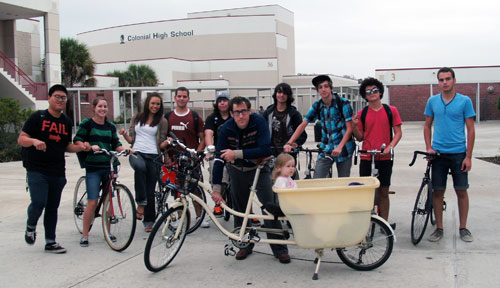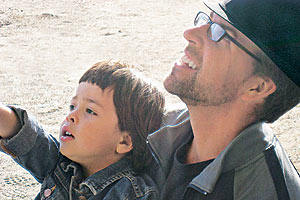I have reported on how Florida's dearth of walkable and bike-able streets results in damage to the planet and to human bodies. Ben Fried at Streetsblog wrote a terrific summary of the health and environmental benefits of walkable urbanism (see graph below), as discussed by the experts in Copenhagen.
But also on Streetsblog, I discovered that a group of teenagers are taking the same message directly to the Orlando, Florida streets–by forming their own "bike bus," in which a group of bicyclists clump together for visibility along a specific route and timetable. Here's a fun little video:
High School Bike Bus from Keri Caffrey on Vimeo.
One of the teens writes:
For the bike bus in the video, there were about 15 kids. It is a regular thing and new people are joining the club and bike bus every day. They have set it up that they plan on riding unless otherwise noted. The kids treat it like an actual bus. Several kids have seen the bus pass by day after day and then decide to join it. There is a set start point and other kids join in along the ride.
This club is definitely "the thing" to do at the school right now. The school is located in a district where a lot of people ride out of necessity, so I can't say cycling was a cool thing before. I would say many people saw people riding and associated it with the poorest members of their community. The club is changing perceptions among the students for sure. Additionally, these kids understand that they are changing perceptions about Orlando as a cycling city and they are all over it.
The video concludes: "They want to ride to school. So they do." One can hope that in time this will lead to changes in the design of Florida's streets.

The benefits of urban spaces in which people share transportation are substantial. In the graph above, BTU stands for British Thermal Unit, and this shows how much heat energy different kinds of housing generate–note that a detached suburban house results in almost five times the transportation energy use of an urban attached house, and home energy use falls dramatically with density. This is why quality of life urban issues like housing and transit are in many respects environmental issues. Fried's Streetsblog piece mentions some great case studies of how to win public support for public transit and bike paths:
Since most Americans aren't all that familiar with walkable urbanism, the question of how to generate public support for more sustainable development patterns inevitably arises. John Inglish of the Utah Transit Authority shared some of the successes on this front from his home state. It's a bit of an old story, but it's a good one: In the late 1990s, the public-private venture Envision Utah began a campaign to shape regional growth in the Salt Lake City region.
Through a series of public workshops, they built support for smart growth strategies that became state law in 1999. How did they do it? Inglish focused on the sheer fiscal common sense of walkable urbanism. When presented with the fact that transit investment produces huge savings in overall infrastructure costs, Utahns got on board.
By 2020, a transit-oriented growth scenario would save some $15 billion, which would otherwise go to roads, sewers, and other utilities under the sprawling business-as-usual scenario. "That's more money for schools and parks," Inglish said. "The community was not as conservative when faced with the realities as had previously been thought."









